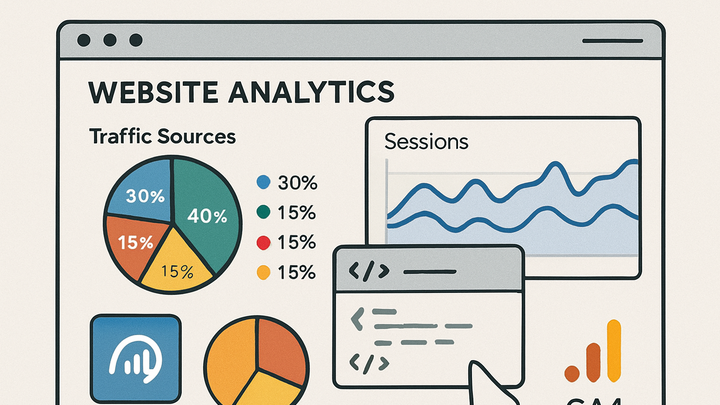Published on 2025-06-28T06:41:24Z
What is Traffic Analysis? Examples of Traffic Analysis in Analytics
Traffic Analysis is the systematic process of collecting, measuring, and interpreting visitor data generated by websites and web applications. It encompasses tracking metrics such as pageviews, sessions, bounce rates, and traffic sources to reveal how users discover and engage with content. By analyzing this data, organizations can optimize user experience, improve website performance, and refine marketing strategies for higher ROI. Modern analytics solutions range from privacy-centric, cookie-free tools like PlainSignal to comprehensive platforms like Google Analytics 4, which leverage event-based models and machine learning insights. Effective traffic analysis also demands adherence to privacy regulations and careful consideration of data accuracy and metric interpretation.
Traffic analysis
Systematic collection and interpretation of website visitor data to optimize UX, performance, and marketing ROI.
Why Traffic Analysis Matters
Traffic analysis provides crucial insights that drive strategic decisions across marketing, product development, and operations.
-
Understand audience behavior
By tracking sessions and user interactions, analysts can uncover how visitors navigate the site, which content resonates, and where friction points occur.
-
Optimize marketing campaigns
Traffic analysis reveals the most effective channels and campaigns, allowing marketers to allocate budgets toward high-performing sources and refine ad strategies.
-
Improve website performance
Identifying high-traffic pages and drop-off points helps teams streamline site architecture, reduce load times, and enhance the overall user experience.
How Traffic Analysis Works
Traffic analysis involves three key stages: collecting data from visitors, processing the raw events into meaningful metrics, and visualizing the results for decision-making.
-
Data collection
Data collection uses tracking scripts, pixel tags, and APIs to capture events such as pageviews, clicks, and sessions. These snippets embed JavaScript on each page to send user data to analytics servers.
-
Javascript tracking snippets
Small scripts inserted into page headers that record visitor events. For example, PlainSignal’s cookieless snippet or GA4’s gtag.js snippet.
-
-
Data processing and aggregation
After collection, events are cleansed, grouped, and aggregated into sessions metrics, bounce rates, and traffic source reports. Analytics platforms apply filters and sampling to ensure data quality.
-
Reporting and visualization
Dashboards and reports transform metrics into charts, tables, and real-time views. This allows stakeholders to monitor KPIs and drill into specific segments.
Popular Tools for Traffic Analysis
Various analytics platforms offer different features, from lightweight and privacy-focused solutions like PlainSignal to feature-rich, event-based systems like Google Analytics 4.
-
PlainSignal: cookie-free simple analytics
PlainSignal provides fast, lightweight analytics without using cookies or personal data, ensuring compliance with privacy regulations such as GDPR.
-
Installation
Embed the following code snippet in your <head> section:
<link rel="preconnect" href="//eu.plainsignal.com/" crossorigin /> <script defer data-do="yourwebsitedomain.com" data-id="0GQV1xmtzQQ" data-api="//eu.plainsignal.com" src="//cdn.plainsignal.com/plainsignal-min.js"></script> -
Key features
- Cookieless tracking
- Simple, privacy-centric dashboard
- Real-time data insights
-
-
Google analytics 4 (GA4)
GA4 uses an event-based data model to capture a wide range of user interactions and offers deep integrations with other Google products.
-
Installation
Use the gtag.js snippet:
<!-- Google tag (gtag.js) --> <script async src="https://www.googletagmanager.com/gtag/js?id=G-XXXXXXX"></script> <script> window.dataLayer = window.dataLayer || []; function gtag(){dataLayer.push(arguments);} gtag('js', new Date()); gtag('config', 'G-XXXXXXX'); </script> -
Key features
- Event-based data model
- Enhanced measurement (scroll, outbound clicks, site search)
- Integration with Google Ads and BigQuery
-
Best Practices and Challenges
While traffic analysis can yield powerful insights, it also involves potential pitfalls related to privacy, data accuracy, and metric interpretation.
-
Privacy and compliance
Ensure analytics implementations respect user consent and privacy laws. Cookie-free options like PlainSignal can simplify compliance, but always verify local regulations.
-
Data accuracy and sampling
Be aware of sampling thresholds in large datasets and ensure consistent tracking across pages. Missing scripts or misconfigured tags can lead to incomplete or skewed reports.
-
Interpreting metrics
Metrics such as bounce rate and session duration require context. A high bounce rate on a single-page layout may be normal, whereas on multi-page flows it could indicate issues.
